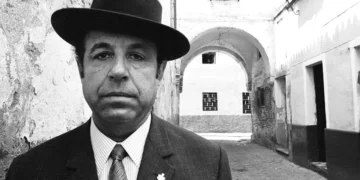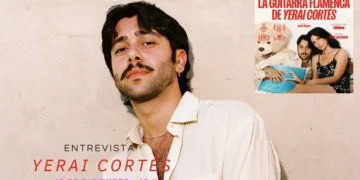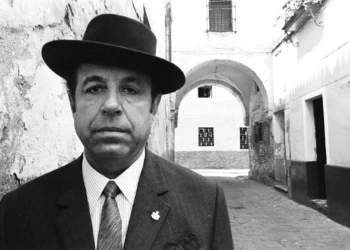|
| Daily coverage BIENAL DE FLAMENCO sponsored by: |
Carmen Amaya: Evocaciones
Cante: Macarena Girádez, Vicente Gelo, El Galli, Pepe
de Pura, Mari Bizárraga. Colaboración especial: Rafael
de Utrera. Dance: Juana Amaya, Nazarét Reyes, Nano, Ma. del
Mar Montero, Marcos Jiménez, María Ollero. Dancer-acrobat:
Raquel Ramírez. Guitar: Paco Fernández, Niño
Manuel, Andrés Martínez. Percussion: José Carrasco,
Antonio Maya. Violin: David Moreira. Cello: Ángel Morilla.
Director and original idea: Pilar Távora. Special guest artist:
Rafael Amargo
The critic’s job is no easy one. Not so much because
of the complexity of flamenco which leads to normal human error,
but because the need to be honest often means having to express
opinions that may seem like personal insults to the performers,
something that should never happen because we do not speak of the
individual, but rather his or her work. In this light, the magnificent
dancer Juana Amaya should take it as constructive criticism when
the suggestion is made to find herself other artistic companions
because in “Carmen Amaya: Evocaciones” her current ones
are definitely doing her harm. And we don’t mean Rafael de
Utrera (one of the guest artists) who interpreted a profound martinete,
nor Macarena Giráldez who, personal taste aside, has a powerful
gypsy voice, but rather the group of guitarists and singers who,
while not exactly being worthy of death by torture, are not what
an artist like Juana Amaya deserves. We’ll get to Rafael Amargo
further on.

Lope de Vega lent its stage to the task of evoking the memory of
the legendary Carmen Amaya. And no one better than Juana, small
and temperamental, to get the job done. The curtain goes up and
Macarena Giráldez appears, rocking, singing a lullaby…suspended
from the ceiling, an acrobat-dancer. Already the staging was off-putting,
and not necessarily because of the circus-like descent. There was
a certain beauty to the whole thing, but it was unnecessary. Nazaret
Reyes, Juana’s daughter, appears as if from nowhere on the
floor, and this is understand to represent an infant Carmen Amaya
who gingerly slips on dance shoes, stands and fixes her gaze on
the audience. Head erect, the gestures, the arms, the curving of
the torso and the way of taking on the dance may make this young
dancer one of the most talked-about dancers in the near future.
The high point was her table-top bulerías.
Juana Amaya’s dancing is temperamental,
her posture elegant and she always moves with decision
The show is made up of six acts representing arrival, genius,
dancing, work, world fame and departure, some parts introduced by
videos, narratives and projected images. Juana Amaya slips into
the role of Carmen and dances like one possessed. The choreography
doesn’t appear to be rehearsed, the footwork feels spontaneous,
the shoulder and hand movements and how she picks up her dress and
moves it, all combine into a natural projection which differs from
the typical dance school routine we’ve become so accustomed
to with other dancers, a sort of dance by the numbers. Juana Amaya’s
dancing is temperamental, her posture elegant and she always moves
with decision – there’s no doubt who the star of the
night is.
And Amargo… He comes out from under wraps, rises from the floor
wearing only briefs, and begins to dance around or whatever you
want to call this style which is announced as “dancing the
way people from Seville like”. It’s entirely offensive
that anyone should think what he produced on stage is to the liking
of a demanding audience. Part of the blame must fall upon Pilar
Távora, that’s why her name is in bold letters on the
program as responsible for having created and directed the work.
It’s unfortunate Juana and Rafael are thrown together, because
the only result is more media coverage, a few famous faces in the
audience, and the destruction of something that could be been worthwhile.
The quality, or lack of same, is the responsibility of the performer,
but the show, which purportedly was evoking the memory of Carmen
Amaya, and even manages to do so now and again, belongs to the creator-director.
Rafael Amargo knows how to do turns and wave his arms around theatrically,
and on this item we shall reserve comment, but his unfortunate performance
will take some time to disappear from the collective retina. He
joined Juana for a pas de deux and the comparison was glaringly
evident. If this is the new wave, I for one don’t get it.
Nor am I interested in getting it. Ole Juana!
Text : Kiko
Valle.
“Canta y baila
Jerez”
Cante: El Capullo, El Torta, Fernando de la Morena, José
Méndez. Dance: Mercedes Ruiz. Guitar: Diego del Morao, Miguel
Salado, Diego Amaya
Like they say, “tell me something I don’t know”.
The title of the show, “Jerez sings and dances”, is
not a hot news item by any means, but the fact that what took place
on the stage of the Hotel Triana Thursday night September 9th has
been the best show to date in the Bienal, sends a clear message
to avant-garde producers and artists permanently in search of novelty,
the never-before-seen, the shocking, not to mention the public Euro.
With just four singers and one dancer, each with corresponding accompaniment,
all from Jerez, with no artifical coloring or flavoring, with honesty
and dedication, a banquet of the highest quality flamenco was served
up.
Singer José Méndez started out, short on voice but
long on compás, shouting a bit too much, but recalling his
aunt Paquera and his neighborhood of San Miguel with alegría,
soleá por bulería and bulerías. Young Miguel
Salado on the guitar showed a strong influence of Paco Cepero in
whose group he often plays, and is quickly acquiring self-confidence
and polish.
 |
 |
|
|
Fernando de la Morena y Diego
del Morao |
El Torta y Diego del Morao
|
Capullo de Jerez
|
The irresistible sound, the unmistakable phrasing and original
personality of Fernando de la Morena with Diego de Morao accompanying,
got the knowledgeable audience raring for more and provoked the
collective “ole!” again and again with soleá,
fandangos and bulerías.
With no artifical coloring or flavoring,
with honesty and dedication, a banquet of the highest quality flamenco

Mercedes Ruiz, queen of subtlety, serene and fascinating, dressed
in white, raised our old friend bulerías to the level of
serious dance without any need for strained faces or false tension,
with truly magical movements and not one ‘desplante’.
What’s that thing she does with her hands that looks like
she’s taking to the air?
Capullo did his Capullo number and the audience was delighted.
Although he wasn’t really “on”, he quickly found
his personality with the help of guitarist Diego Amaya who accompanied
the soleá por bulería, a cante whose anarchic character
is well-suited to this anarchic singer, fandangos and tangos that
were more popular than traditional.
Torta closed out the night with Diego de Morao and it was an inspired
last-minute change in the program because the singer was really
hot, and when it’s Torta we’re talking about, that’s
a mouthful. With his savage delivery he turned taranto and cartagenera
into a local product, and an assortment of malagueñas was
followed by bulerías. He began bulerías in a tone
that was not the same as the guitar’s, but Diego quickly fished
out the chords. Torta is a singer who inspires extreme devotion
and his most demanding followers had no cause for complaint this
night of Jerez cante in Triana.
Text & photos: Estela
Zatania
|
|
Related products:
|
|























